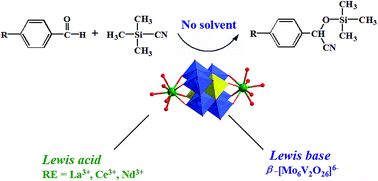Lanthanide-supported molybdenum–vanadium oxide clusters: syntheses, structures and catalytic properties†
Abstract
Three new lanthanide-supported molybdovanadates [Ln(H2O)5]2Mo6V2O26·8H2O (Ln = La 1; Ce 2; Nd 3) have been synthesized by the reaction of the [Mo6V2O26]6− anion with Ln(NO3)3 in aqueous solution and characterized by elemental analysis, IR, solid state UV-vis spectroscopy, thermal gravimetric analysis, powder X-ray diffraction and single-crystal X-ray diffraction. Compounds 1–3 are obtained at the same pH value (3.0) and have similar structural units which consist of one molybdovanadate unit supported by two lanthanide cations. Then, these bi-supporting subunits are joined together by strong hydrogen-bonding interactions between polyoxoanions and coordinated water molecules to form a 3D supramolecular framework. To the best of our knowledge, they represent the first examples of inorganic species constructed from molybdenum–vanadium polyoxometalates and lanthanides. The UV-vis diffuse reflectivity spectra of 1–3 show that they can be regarded as a wide gap semiconductor. Photocatalytic studies indicate that compounds 1–3 are not only active photocatalysts for degradation of rhodamine B, but very stable and easily separated from the photocatalytic system for reuse as well. Moreover, the new materials were tested as catalysts in cyanosilylation reactions of aldehydes under solvent-free conditions. The experimental results indicate that all three compounds 1–3 can act as Lewis acid–base catalysts through a heterogeneous manner to prompt cyanosilylation with good efficiency.


 Please wait while we load your content...
Please wait while we load your content...